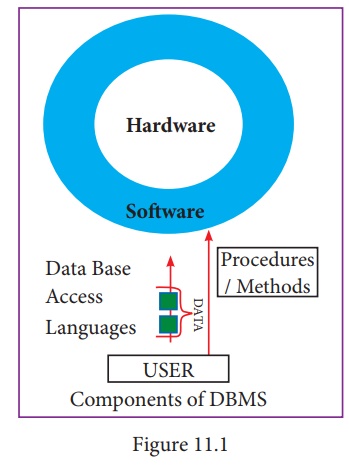Chapter: 12th Computer Science : Chapter 11 : Database concepts and MySql : Database Concepts
Database Concepts
Introduction
A database is an organized collection of data,
generally stored and accessed electronically from a computer system. The term
"database" is also used to refer to any of the DBMS, the database
system or an application associated with the database. Because of the close
relationship between them, the term "database" is often used casually
to refer to both a database and the DBMS used to manipulate it. A school class
register is a database where names are arranged alphabetically. Databases have
been around since people started recording things. Here we tend to focus on
electronic ones.
Data
Data are raw facts stored in a computer. A data
may contain any character, text, word or a number.
Example : 600006, DPI Campus, SCERT, Chennai,
College Road
Information
Information is formatted data, which allows to
be utilized in a significant way.
Example
SCERT
College Road
DPI Campus
Chennai 600006
As
you can see from the example above, data appears as a
set of words and numbers. However, when the data is processed, organized and
formatted, it gives a meaningful information about the SCERT institution
contact address.
Database
Database is a repository collection of related
data organized in a way that data can be easily accessed, managed and updated.
Database can be a software or hardware based, with one sole purpose of storing
data.
DataBase Management System (DBMS)
A DBMS is a software that allows us to create,
define and manipulate database, allowing users to store, process and analyze
data easily. DBMS provides us with an interface or a tool, to perform various
operations to create a database, storing of data and for updating data, etc.
DBMS also provides protection and security to the databases. It also maintains
data consistency in case of multiple users.
Examples of DBMS softwares are : Foxpro, dbase.
Characteristics of Database Management System
1. Data stored into Tables
Data is never directly stored into the
database. Data is stored into tables, created inside the database. DBMS also
allows to have relationship between tables which makes the data more meaningful
and connected.
2. Reduced Redundancy
In the modern world hard drives are very cheap,
but earlier when hard drives were too expensive, unnecessary repetition of data
in database was a big problem But DBMS follows Normalisation which divides the
data in such a way that repetition is minimum.
3.Data Consistency
On live data, it is being continuously updated
and added, maintaining the consistency of data can become a challenge. But DBMS handles it by itself.
4. Support Multiple user and
Concurrent Access
DBMS allows multiple users to work on
it(update, insert, delete data) at the same time and still manages to maintain
the data consistency.
5.Query Language
DBMS provides users with a simple query
language, using which data can be easily fetched, inserted, deleted and updated
in a database.
6. Security
The DBMS also takes care of the security of
data, protecting the data from unauthorized access. In a typical DBMS, we can
create user accounts with different access permissions, using which we can
easily secure our data by restricting user access.
7. DBMS Supports Transactions
It allows us to better handle and manage data
integrity in real world applications where multi-threading is extensively used.
Advantages of DBMS
·
Segregation of application program
·
Minimal data duplication or Data Redundancy
·
Easy retrieval of data using the Query Language
·
Reduced development time and maintenance
Components of DBMS
The Database Management System can be divided
into five major components as follows:
1.Hardware
2.Software
3.Data
4 . Procedures / Methods
5.Database Access Languages

Hardware: The computer, hard disk, I/O channels for data, and any other physical component
involved in storage of data
Software: This main component is a program that controls everything. The DBMS software
is capable of understanding the Database Access Languages and interprets into database commands for execution.
Data: It is that resource for which DBMS is designed. DBMS creation is to store and utilize
data.
Procedures/Methods:
They are general instructions to use a database
management system such as installation of DBMS, manage databases to take
backups, report generation, etc.
DataBase Access
Languages: They are the languages used to write
commands to access, insert, update and delete data stored in any database.
![]() Examples of popular DBMS: Dbase, FoxPro
Examples of popular DBMS: Dbase, FoxPro
Related Topics